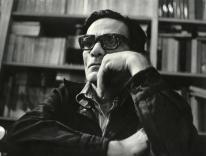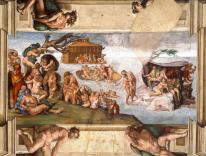We went to the Hartford Stage to see a performance of The Body of an American which will run there until the end of January. The play offered a great deal in a ninety minute, two-man performance. I scarcely felt the time pass, so quick and intense the shifts in characters’ voices and in the vignettes from the life of the photo-journalist , Paul Watson [Michael Cumpsty], who is the focus of the play. The playwright, Dan O’Brien, as his character [Michael Crane] makes clear, found Watson’s reporting from war zones, scenes of genocide, civil conflicts, and Artic Canada unavoidably compelling. He engaged in email correspondence and phone calls in an attempt to know the man who had taken such risks and witnessed appalling modern conflicts. The characters then offer the playwright’s personal search and the photographer’s response to his troubled experiences.
To make compelling theatre out of a series of stage interviews, by phone, email and finally in person, is a testimony to O’Brien’s art. The canny use of projected visuals and remarkable sound effects helped suspend disbelief. But in fact there was a distancing reassurance in the play’s mechanics, its notion of being a made thing. This was an imitation of an action – and with Aristotle in mind, there was a conflict, complication, and a muted climax, or perhaps series of high points.
The work of getting the story told, which could have caused awkward exposition, appeared effortless, in part because of the pace of the play and the ease with which the actors changed roles, dove-tailed their lines, and gave convincing portrayals.
The thematic focus is the haunting of the photographer (References to ghosts dominate the lines of both characters.) by a picture he took of the near naked body of an American soldier in Mogadishu. As Watson caught the image he heard the corpse say, “Now I own you.” What is the meaning of this ominous warning? And, by extension, what is the ethical stance of one who lives on the tragedies of others, producing for mass consumption images of terror and grief? Yet his career is made of such images. The ethical torment is trumped by the moral horror over the waste of human life and the folly of so much warfare and slaughter. How does a photo-journalist live with himself?
In the case of the playwright, O’Brien, the very status of a man who lives on the edge, facing daily risks, experiencing the worst of human behavior, appears to call for an understanding that might clear his own internal wars. Extraordinarily, O’Brien avoids sentimentalizing his character’s familial battles. In fact his openness with Watson on this very matter occasions their climactic meeting in the Canadian Artic. In a world that recalls Mary Shelley’s depiction of the meeting of monster and maker – the special effects here were singularly chilling - we have a parallel but wholly successful meeting.
The play does us the good favor of avoiding easy assertions or platitudes. The frustrations of the characters and their honest compassion say enough about what they face and what the know of themselves. At one point, again handled with a deft simplicity, Watson reports on his brief meeting with Mother Teresa. He dismisses her focus on dying AIDS patients as too little attentive to their physical hunger. He is forced to revise his judgment when he hears her retort, that the dying do not need food, they need love. This is the affirmation with which the play leaves us – even as the two characters depart with tentative pledges to meet again.
Please email comments to [email protected] and join the conversation on our Facebook page.
Share
Previous Story
The State of the Union's Anxiety
Next Story
Letter from Rome


